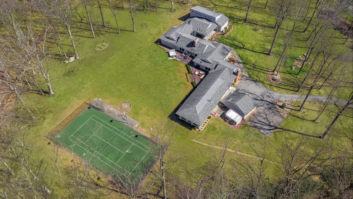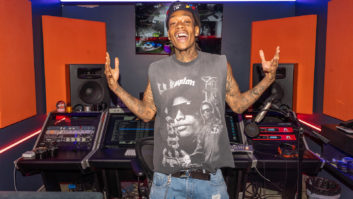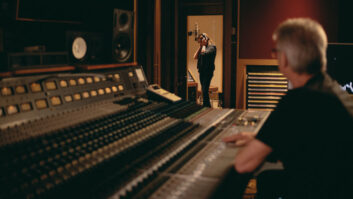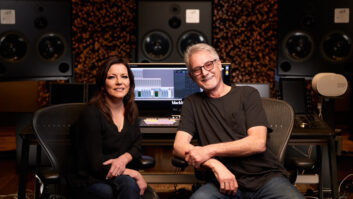In late 1970, The Stooges’ raucous LP Fun House was released to a nearly unanimous critical drubbing, poor sales and virtually no radio play. However, the ferocious proto-punk recording has gained near-legendary status during the past 30 years, and now true Fun House fanatics can bear belated witness to almost every moment of the album’s creation. This is possible thanks to Rhino Handmade’s seven-CD set The Complete Fun House Sessions, a limited, 3,000-set, Internet-only release.
“Fun House comes as close as any one record ever will to encapsulating what rock is, was and always will be about,” according to the Trouser Press Record Guide. And a major part of the power of Fun House comes directly from the unusual live-in-the-studio recording technique employed by The Stooges and producer Don Gallucci.
Fun House was the Stooges’ second and final recording for the Elektra label, which, prior to signing The Doors, was primarily a folk music outfit. However, the Detroit-based Stooges were far from earnest folkies; they even had the audacity to form the band before mastering the basics of their instruments. By the time they cut Fun House, they had progressed mightily (thanks to more than a year of constant touring) into a potent, smart and proudly less-rudimentary group whose sound was about as far from plaintive folk picking as possible in the pop realm.
Fun House was recorded live in Elektra’s then-new (and now defunct) Los Angeles studio, producer Don Gallucci explains from his real estate development office in California (he left the music business shortly after Fun House). The band set up just as they would have onstage and did not utilize baffles to separate the sounds. Lead singer Iggy Pop sang into a handheld microphone (possibly an Electro-Voice model, sans pop screen) and was right there amid the unbaffled amps and drums, moving about wildly during the recording, much as he did onstage. Instead of using headphones, P.A. speakers provided the vocal foldback, Gallucci notes.
The vocals on Fun House have long been rumored to have been recorded by microphones placed in front of the speakers of an in-studio vocal P.A. system. The memories of the two participants Mix interviewed-producer Gallucci and Stooges guitarist Ron Asheton-differ somewhat. Gallucci recalls small, club-style P.A. speakers of some sort in the room with the band, but does not believe the speakers were miked or baffled. Asheton says that there was a large Electro-Voice Eliminator-style P.A. cabinet in the room, which was heavily baffled and possibly miked.
Gallucci believes that any vocal sounds resembling those from a miked P.A. system probably came from the visceral, live-onstage manner of the singer’s interaction with his microphone and from the bleeding that was encouraged by the lack of baffles. “Iggy was using the mic just like he did onstage, and you’re going to get distortion that way,” he says. “We used limiters, but there is only so much they can do! We didn’t think it hurt for this record to have distorted vocals.” He adds that the primary reason for having the vocal P.A. speakers in the room was that “no one wanted to wear headphones, except for Ron Asheton.”
Whatever the precise setup, taking the live-in-the-studio recording approach to this extreme degree was highly effective. Running directly counter to the industry’s standard isolated and meticulous vocal recording process, Iggy held the mic in his hands and romped about as he sang, Gallucci says. He indeed regularly put out too much sound pressure, giving certain passages a nearly frightening, distorted emphasis. This, coupled with the band’s confidence after a year on the road, and their comfort with this highly unorthodox recording style, contributed to a ferocious sound.
Musically, Fun House took the simplicity and garage-band sound of the band’s relatively tame debut Elektra release, The Stooges, and revved it past the redline. The precise and imaginative playing of lead guitarist Asheton; the dead-on rhythm section of his brother, drummer Scott Asheton, and bassist Scott Alexander; and the provocative avant-jazz wailing of tenor saxophonist Steven Mackay all leap off the record and into your solar plexus. Oh, and the riotous songs are good, too.
The Stooges would make one more record (for Columbia), 1973’s David Bowie-produced Raw Power, and Iggy Pop would go on to a roller-coaster solo career that found him doing many other albums for a variety of labels, often under Bowie’s aegis. He also fought a long, semipublic battle with the serious substance abuse problems that reportedly began prior to the Fun House sessions.
In the past decade, however, Pop has become a solid, professional, worldwide touring success and has recorded several albums in a row for Virgin. His records still avoid hit status domestically, but his wild live performances showcase his energy, bold theatrics and unmistakable command of the stage.
Meanwhile, Fun House has sold fewer than 89,000 copies in the nearly 30 years since its release (according to a recent New York Times article), so few ever expected to hear more from those May 1970 sessions, especially not the 30 takes of “Loose” and the dozen each of “Dirt” and “T.V. Eye” found on The Complete Fun House Sessions. However, the direct-sales capability and affordable marketing reach of the Internet have made this highly unusual documentary release practical.
One should not expect to see other well-regarded albums receive this exhaustive archival treatment, however. Again, the way Fun House was recorded led directly to the label’s ability to produce such an unusual set. Had Fun House been made like a normal record of the era (with the instrumental tracks cut first and the vocals added later) the session’s multitracks would’ve probably been discarded after the final takes were spliced into a comp reel for mixdown, opines the remastering engineer, Rhino staffer Bill Inglot.
But each of the more than 100 takes on The Complete Fun House Sessions was recorded complete, final lead vocals and all. (Inglot calls Pop’s consistently strong vocals on take-after-take “a Herculean effort.” Minimal overdubbing was added to some of the album’s tracks, mostly Mackay’s sax and a second track of Asheton’s guitar.) And the dozen 1-inch, 8-track multis that comprised the session “took up little more than a 12-inch cube of space in Elektra’s vaults,” Inglot notes, perhaps explaining why all of the multitracks survived.
The recording technique of Fun House isn’t the only thing about the record that is unusual. Like other seminal rock groups from the 1960s, including The Byrds and The Doors, The Stooges loved the work of the innovative jazz saxophone giant John Coltrane. (The surviving Doors have often noted that their hit “Light My Fire” was built around the chord changes of Coltrane’s acclaimed and popular version of “My Favorite Things.”) Detroit-area rock bands of the time embraced avant-garde jazz with particular fervor. In addition to Coltrane, The Stooges were also enamored of the atonality and fragmented melodies of Archie Shepp and, on the pop front, James Brown.
“We all loved John Coltrane,” explains Asheton in The Complete Fun House Sessions’ liner notes. “When we heard The Doors’ record [The Soft Parade, with sax solos by Los Angeles jazz stalwart Curtis Amy], we thought we could do it better-so we got Steve Mackay, who was a cool guy and a great saxophone player.”
“I was listening to James Brown and a lot of Coltrane,” Iggy Pop adds in the liner notes. “What James Brown was coming up with at that time, with ‘Say it Loud, I’m Black and I’m Proud,’ ‘Make It Funky’ and ‘I Can’t Stand Myself,’ was just minimal, high-steppin’, badass rock music, and that upped the ante…I wanted something badder based on that.”
Gallucci, the suit-and-loafer-wearing badass at the helm, was a young Elektra staff producer who had just scored an AM radio hit with Crabby Appleton’s “Go Back.” Gallucci accepted the assignment after seeing a chaotic New York City Stooges performance at the behest of Elektra’s founder, the enthusiastic and apparently visionary Jac Holzman. (Gallucci won himself a place in the hearts of The Stooges early on when they learned that at the age of 14 he had played keyboards on The Kingsmen’s infamous recording of “Louie Louie.”)
And so the sessions began in early May 1970. First, the quality of the room sound was addressed. Gallucci and The Stooges rearranged the various Oriental carpets and pillows Holzman had decreed for the new room, which had been designed to be nonreverberant, as was the general studio design trend then, Inglot says. (The studio was designed by Allan Emig and acoustic designer Paul Veneklassen, according to the liner notes.)
“We took out all those carpets and pillows, and we thought, ‘This room is really going to jump now!'” explains Gallucci. “But it was still so dead and so clean! The room sounded like a transistor radio, with no funk. The sound had been eunuched.”
The Stooges had exclusive use of the studio for a two-week period, so the rearranging only had to be done once, Asheton says. Once the furniture was rearranged, the tunes were run through using a conventional live approach, with the amps and drums heavily baffled, the singer using a studio-style microphone on a boom and everyone wearing headphones. The results were extremely disappointing.
“We all knew it was awful,” says Gallucci. “However, there was no subsequent big discussion about a different recording technique. Iggy was clearly frustrated. He wanted to have close contact with his guitarist. He wanted to be able to lean over into Ron’s amp and hear the guitar jump out at him. I knew nothing could sound worse than what we had, so we got rid of the baffles, set the band up just as they would be onstage and brought in the P.A. speakers [and split the singer’s mic feed between the P.A. amplifier and the recording console].
“That way Iggy could be comfortable and have the live sound experience he was used to, and he didn’t need headphones. We absolutely wanted everything to bleed. That gave us the much-needed natural sound quality and the familiar aural environment the band wanted,” Gallucci says. “I think some of the best recordings-at least in terms of fatness, texture and warmth-were made with one microphone at the back of a bar, so I thought it was at least worth a try.”
Asheton confirms the close quarters. “My amp was right next to my brother Scott’s drum kit, and the bass amp was right next to mine, and Iggy was right there with us. The really cool thing was that Gallucci wanted the sounds to bleed together,” Asheton says.
Iggy indeed treated the studio as a stage, only somewhat restraining his infamous, energetic and idiosyncratic performance antics as they recorded, Gallucci says. Reissue engineer Inglot notes that the instruments bleeding onto the single vocal track vary from take to take and even during individual takes. “About 30 percent of the modulation on the vocal track is drum hash,” says Inglot.
The instrumental tracks were much less corrupted by bleeding. “Ron Asheton’s guitar is pretty clean, like the mic was right in front of his cabinet, and the bass is exceptionally clean,” Inglot adds. He confirms Gallucci’s recollection that the temporary modifications did little to liven up the room. “Overall, the sound was quite dry” despite the temporary room modifications, Inglot explains. “So for the boxed set we tried to create a room, using Lexicon’s 480 and PCM70 reverb units.”
As for the extraordinarily punchy, center-stage quality of the instrumental sound, Gallucci says there were two contributing factors aside from the live approach. “One, the sound was unique to the time and the sensibilities of the band,” he explains. “And our engineer, Brian Ross-Myring, came from the old school, when recording was an elegant gentleman’s business, when engineers were men who wore French cuffs.” Ross-Myring’s traditional background dictated that no matter how outrageous the music, one should not lose sight of the basics. “A guitar should sound like a guitar and a sax like a sax,” says Gallucci. “Brian accomplished that and also enhanced the warmth we were after.”
(Ross-Myring, who was middle-aged in 1970, and whose session previous to Fun House is said to have been with Barbra Streisand, is deceased, as is saxophonist Mackay.)
For the remastering, Inglot tamed some of the wilder dynamics with peak limiting compression, employing “an old ’50s-era LA-250 tube limiter on the vocals. Say the dynamic range was 60 dB; I’d pull it down to 50 dB,” he says. The original Fun House 1-inch, 8-track 3M multitracks were pulled from Elektra’s vault and played back on a 3M-1 8-track machine at Penguin Recording in Eagle Rock, Calif., and mixed on a small Neotek board. “We used a bit of outboard EQ, and mixed to quarter-inch tape on an Ampex 100 deck at 15 ips. We used Dolby A, to lose some of the noise floor, rather than Dolby SR, because we thought Dolby A would be more authentic in relation to the original sessions’ sound. We didn’t mix to half-inch at 30 ips, because we wanted the benefit of a bit of tape compression, plus we felt that bigger, faster tape would just be overkill for a raw-sounding project like this.”
The entire compilation process and remixing took only about 20 hours, Inglot says. “It is virtually a live record. Once you get your sound, you’re rolling with it, changing things a little here and there, mostly to make yourself feel better,” he quips.
Asheton is quite pleased to have been a central part of The Stooges and Fun House, and is proud of the extensive archival reissue. “I’ve heard of a lot of young bands brandishing the Fun House CD in the studio, saying, ‘We want to sound like The Stooges.’ Gallucci had a very cool concept. He wanted to find another aural direction for The Stooges, to capture a total live feeling, one where the sounds would encompass themselves like onstage. And that’s the beauty of that record, because it was as close to our live sound as could be captured in a studio.”
Fun House should be seen in the context of the times and the tenor of the music business, Gallucci says. “Everything in music had gotten so fey. At around the same time as Fun House, I went to this big Columbia Records dinner, and the main event was Simon & Garfunkel performing ‘Bridge Over Troubled Water.’ That’s a beautiful song, but to The Stooges, taking rock and pop and making it so acceptable and refined was sacrilegious. Their whole thing was to go Zen, to cut the music right back to its essence.”
Some copies of the limited edition The Complete Fun House Sessions may still be available from rhinohandmade.com.
Essential reporting for this article was provided by Brian Zabawski, who hipped the author to The Stooges in 1970, when both men were NYU freshmen.







